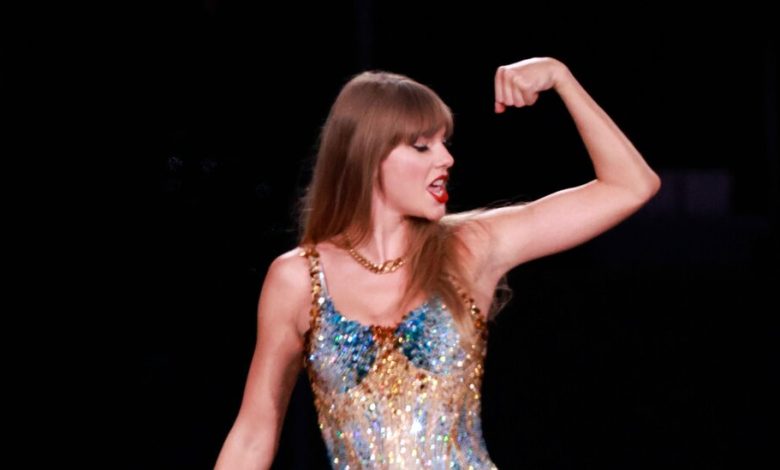How to Command a Stage Without Great Dance Moves (Taylor’s Version)

Since it’s an understatement to call Taylor Swift’s Eras Tour the dominant pop concert of the year, it isn’t surprising that snippets of the show, captured by fans on their phones, have been flooding social media sites for months. Watch a few of these clips, and it might strike you that the dance moves, in contrast to the designer costumes and visual effects, are rather simple and unoriginal, the sort of thing anyone might be able to pull off.
At least that’s what I thought before seeing the Eras Tour live. Experiencing it in Los Angeles, at the end of its first United States leg, I changed my mind. As dance, the show is simple and unoriginal — yet exceptionally effective.
Swift is a pop superstar who dances but is not known for her dancing. Even many of her admirers will admit that in this respect she’s no Beyoncé, no Britney Spears — that as hard as she tries, she’s a little stiff and awkward. Be that as it may, body language is crucial to how the three-hour-plus performance works.
On Friday, at the second of six Los Angeles concerts, the most significant gesture came early, between songs. Basking in the deafening roar of 70,000 fans, Swift struck a coy “Who, me?” pose and said she wanted to try something. She pointed at a section of SoFi Stadium, and the cheering from that section somehow got louder.
“I feel so powerful,” she said, kissing a bicep. But the power she was flexing wasn’t muscular. It was her ability — with the magnification of giant video screens — to connect with every member of the crowd. The choreography helped keep that connection a live wire.
I don’t just mean the dance numbers, though there are plenty of those, choreographed by Mandy Moore (“La La Land,” “So You Think You Can Dance?”). The backup dancers sometimes contributed to the spectacle. They handled the billowing floral parachutes that concealed and revealed Swift at the start. They wielded glowing orbs during “Willow,” clouds on ladders during “Lavender Haze,” umbrellas during “Midnight Rain.” Not especially imaginative, this was all just something big enough to see.
Elsewhere, the dancers helped suggest the situations of the songs. The bicep kiss was a segue to “The Man,” a complaint about gender double standards that was staged as an ascent up the stairs and levels of an office set populated by chest-thumping workers. In other songs, a few dancers played roles: the boyfriend that Swift berates for emotional neglect across (and atop) a long dinner table in “Tolerate It,” or the scandalizing socialite protagonist of “The Last Great American Dynasty.”
But really, the concert has only one character, Swift. In “Look What You Made Me Do,” the dancers were costumed as earlier versions of her, trapped in transparent boxes like dolls. Mostly, though, they served as a friend group or party guests. A happy, diverse bunch, they did a little ballroom dancing to evoke the romantic fantasy of “Lover,” a little vogueing to give “Bejeweled” some shimmer.
And then they left. Which is to say, they left the audience alone with Swift, again and again, re-establishing the thrill of mass intimacy. Other pop stars use this effect, but it’s especially potent with Swift because she’s also a singer-songwriter, who can sit at a piano or tap into the iconography of a guitar-slinging truth teller.
The most intense moments of the show were in this mode: the 10-minute extended version of “All Too Well” and the acoustic mini-set of “secret songs” that differ from night to night. This is almost pointedly not dancing, but it requires a particular physicality at which Swift excels. She has the wide stance, both confident and confiding. She looks grounded, comfortable, at home.
That’s generally true when she isn’t dancing. She can strut or skip around the huge catwalk and stage that extend across the stadium floor without looking small. She can strike over-the-shoulder poses for the camera. She can inhabit her many sparkly costumes — rolling her hips in fringe dresses and Louboutin boots, using the flowy sleeves on her “Folklore” dress the way Stevie Nicks uses scarves.
So does it matter that in the cafe chair burlesque routine for “Vigilante ___,” a homage to louche Bob Fosse dances, she’s imprecise and physically uncommitted to the pleasures and dangers of sex? (She caresses her body like she’s afraid to.) It doesn’t, because her fans love her anyway. And it does, because this imperfect dancing is, I think, part of her nonthreatening Everywoman image. It makes her easier to identify with.
And that is what the whole concert is about, the identification between Swift and the fans she continually thanks and flatters, the fans who know every word to every song. Swift told the L.A. crowd that when those fans sing her lyrics along with her, she takes that as a sign that they too have felt what she felt.
It makes sense, then, that she moves the way anyone might move. So that anyone might imagine being her — just pointing and feeling powerful.




